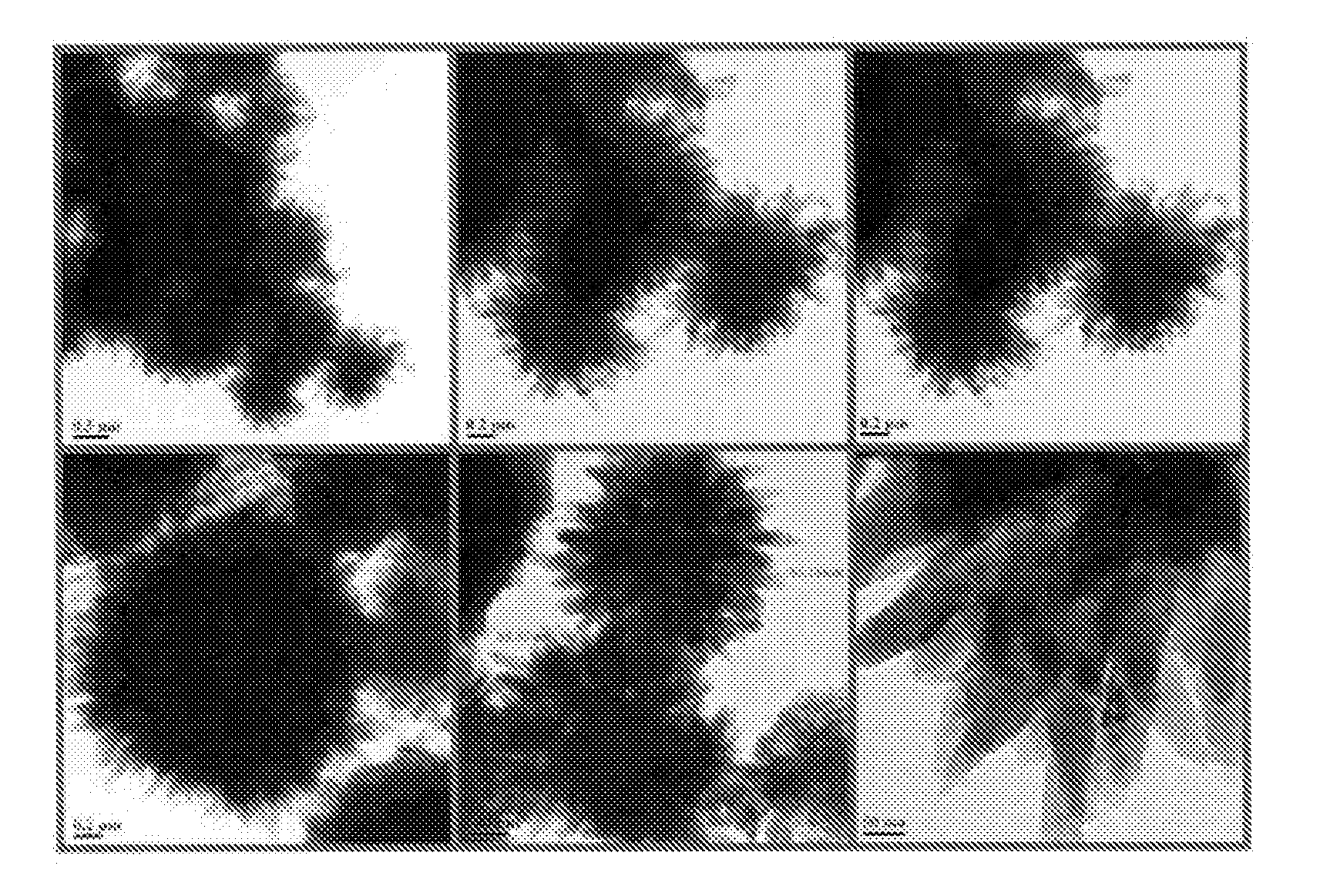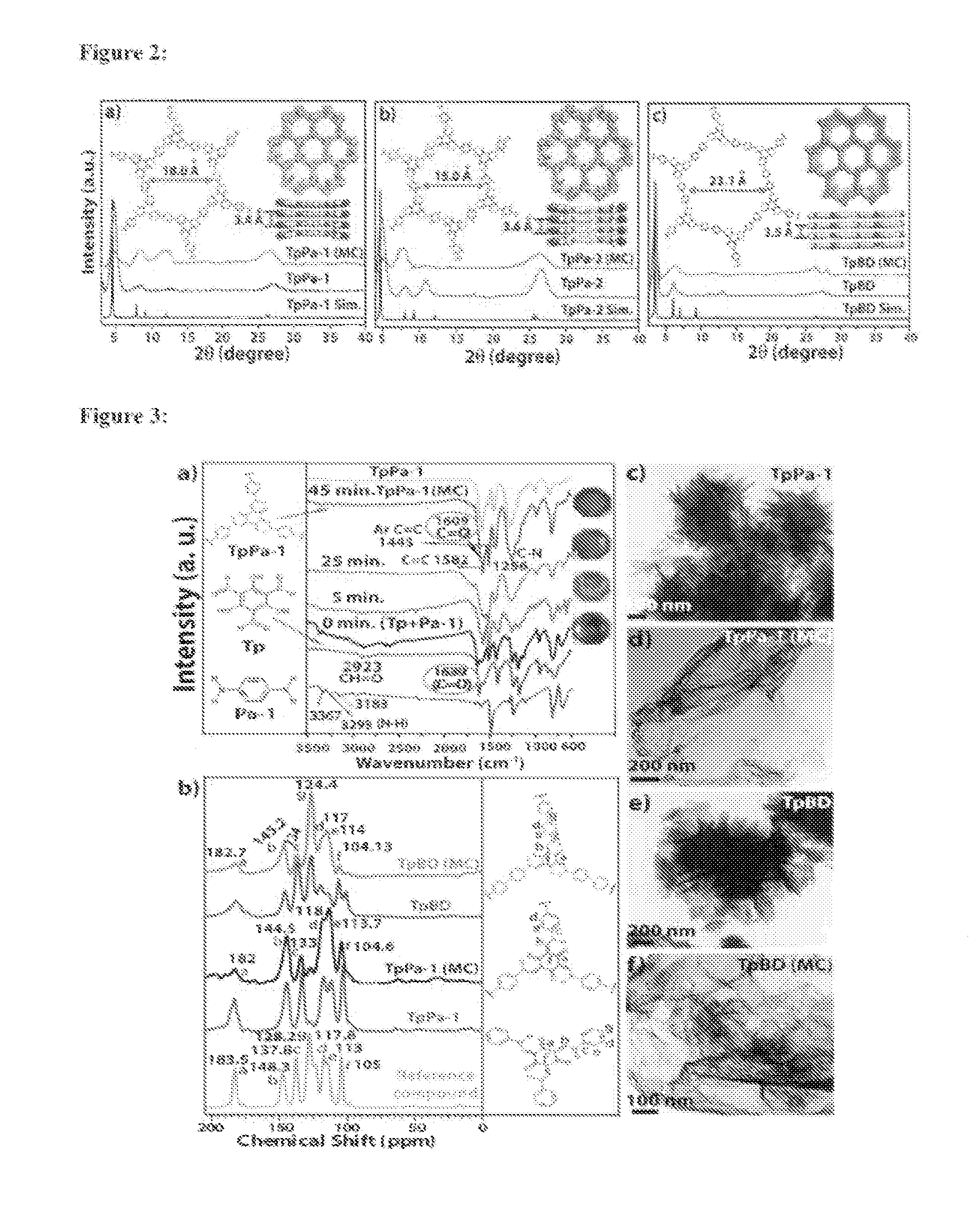Porous crystalline frameworks, process for the preparation therof and their mechanical delamination to covalent organic nanosheets (CONS)
a technology covalent organic nanosheets, which is applied in the field of porous crystalline frameworks (pcfs), can solve the problems of reducing gas adsorption properties, no process for synthesising 2d or 3d covalent organic frameworks, and achieving the same via mechanochemical synthesis is a daunting challenge, and achieves simple, safe and environmentally friendly mechanical grinding.
- Summary
- Abstract
- Description
- Claims
- Application Information
AI Technical Summary
Benefits of technology
Problems solved by technology
Method used
Image
Examples
example 1
[0171]Mechanochemical syntheses of COFs [TpPa-1 (MC), TpPa-2 (MC) and TpBD (MC)]
[0172]Mechanochemical syntheses of COFs [TpPa-1 (MC), TpPa-2 (MC) and TpBD (MC)] were carried out by using Schiff base aldehyde-amine condensation reaction. In the typical synthesis 1,3,5-triformylphloroglucinol (Tp) (0.30 mmol), p-phenylenediamine (Pa-1) [for TpPa-1 (MC)], 2,5-dimethyl-p-phenylenediamine [for TpPa-2 (MC)], benzidine [for TpBD (MC)] (0.45 mmol) and one to two drops of Mesitylene / Dioxane (1:1) (For TpPa-1 we are adding 1,3,5-triformylphloroglucinol (Tp) (0.30 mmol)+p-phenylenediamine (Pa-1) (0.45 mmol); for TpPa-2 we are adding 1,3,5-triformylphloroglucinol (Tp) (0.30 mmol)+dimethyl-p-phenylenediamine (Pa-2) (0.45 mmol), for TpBD we are adding 1,3,5-triformylphloroglucinol (Tp) (0.30 mmol)+benzidine (0.45 mmol)) was placed in a mortar and grounded using pestle at 27° C. which after 5 minutes resulted into light yellow powders (mixture of oligomers and starting materials) (FIG. 1) As time ...
example 2
Solvent assisted synthesis of COF-TpPa-1
[0173]A pyrex tube (o.d.×i.d.=10×8 mm2 and length 18 cm) was charged with Triformylphloroglucinol (TFP) (63 mg, 0.3 mmol), Paraphenylenediamine (PDA) (48 mg, 0.45 mmol), 1.5 mL of mesitylene, 1.5 mL of dioxane, 0.5 mL of 3 M aqueous acetic acid. This mixture was sonicated for 10 minutes in order to get a homogenous dispersion. The tube was then flash frozen at 77 K (liquid N2 bath) and degassed by three freeze-pump-thaw cycles. The tube was sealed off and then heated at 120° C. for 3 days. A red colored precipitate formed was collected by centrifugation or filtration and washed with anhydrous acetone. The powder collected was then solvent exchanged with anhydrous acetone 5-6 times and then dried at 180° C. under vacuum for 24 hours to give a deep red colored powder in 80% (89 mg) isolated yield. IR (powder, cm−1): 1583 (s), 1579 (w), 1450 (s), 1254 (s), 1093 (m), 990 (s), 825 (s). Anal. Calcd. For C80O12N13H48: C, 69.5; H, 3.47; N, 13.87. foun...
example 3
Solvent Assisted Synthesis of COF-TpPa-2
[0174]The synthesis of TpPa-2 was carried out by utilizing the same protocol (example 1) with a mixture of triformylphloroglucinol (TFP) (63 mg, 0.3 mmol), 2,5-dimethylparaphenylenediamine (DPDA), (61 mg, 0.45 mmol), 1.5 mL of mesitylene, 1.5 ml of dioxane, 0.5 mL of 3 M aqueous acetic acid. The reaction mixture was heated at 120° C. for 72 h and after the reaction the red coloured solid at the bottom of the tube was isolated by centrifugation, and washed with acetone. The powder collected was then solvent exchanged with anhydrous acetone 5-6 times and then dried at 180° C. under vacuum for 24 hours to give a deep red colored powder in 82% (isolated yield. IR (powder, cm−1): 2887 (w), 1587 (s), 1446 (s), 1254 (s), 1090 (w), 995 (s), 859 (m). Anal. Calcld. For C80O12N13H48: C, 73.13; H, 5.52; N, 10.9. found: C, 70.52; H, 4.87; N, 10.44.
PUM
| Property | Measurement | Unit |
|---|---|---|
| internal diameter size | aaaaa | aaaaa |
| temperature | aaaaa | aaaaa |
| temperature | aaaaa | aaaaa |
Abstract
Description
Claims
Application Information
 Login to View More
Login to View More - R&D
- Intellectual Property
- Life Sciences
- Materials
- Tech Scout
- Unparalleled Data Quality
- Higher Quality Content
- 60% Fewer Hallucinations
Browse by: Latest US Patents, China's latest patents, Technical Efficacy Thesaurus, Application Domain, Technology Topic, Popular Technical Reports.
© 2025 PatSnap. All rights reserved.Legal|Privacy policy|Modern Slavery Act Transparency Statement|Sitemap|About US| Contact US: help@patsnap.com



